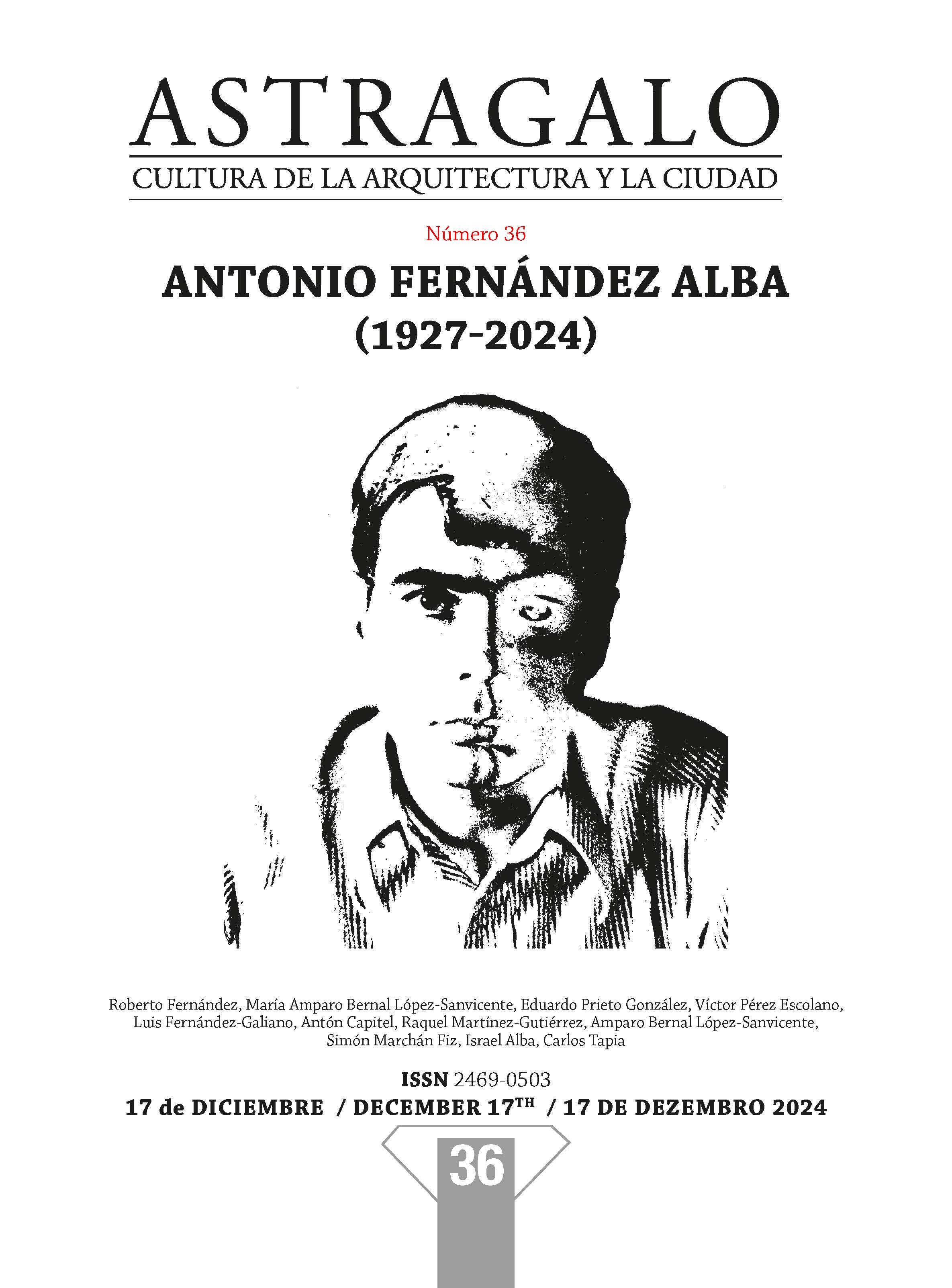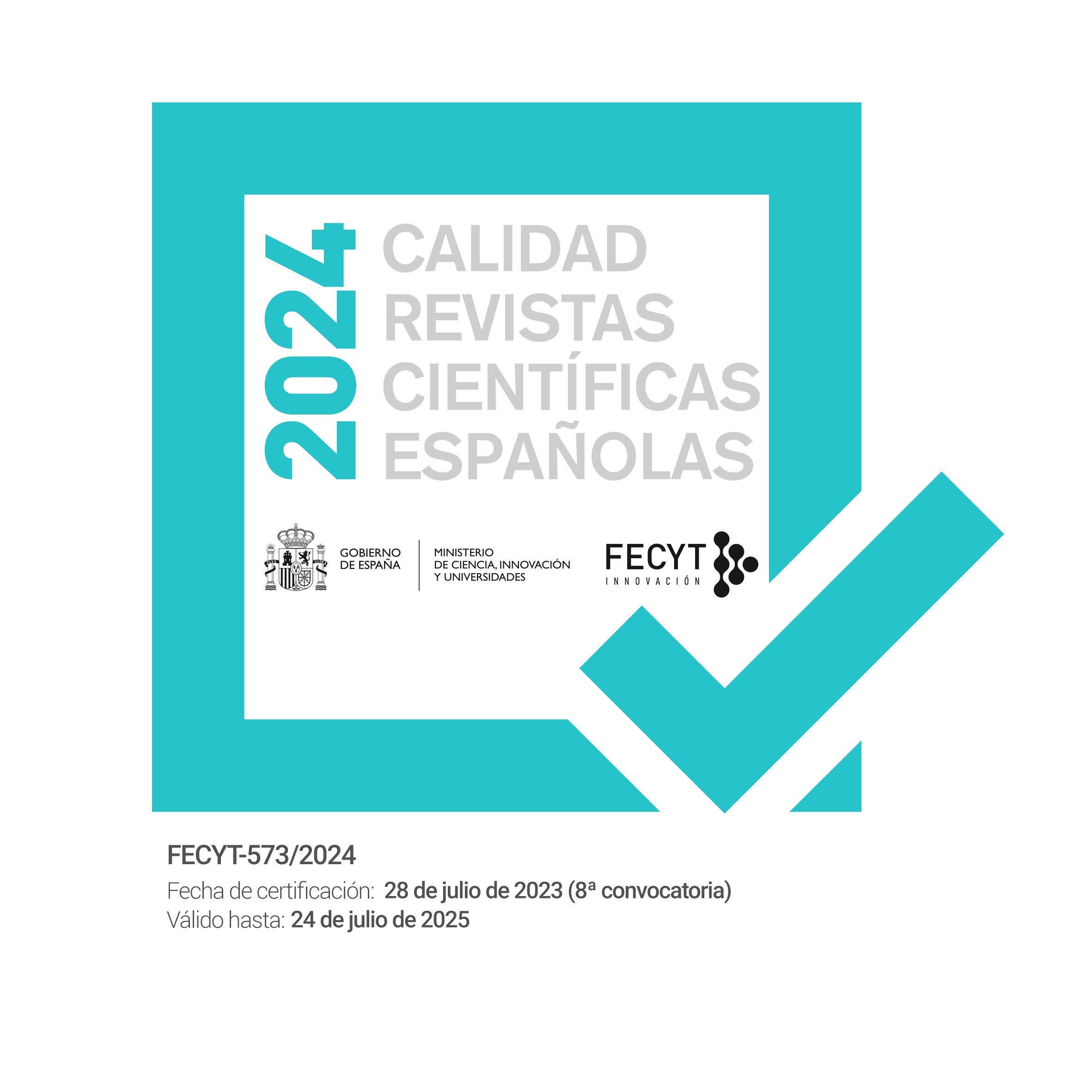Archives
-

Double collapse: ecosistemic and humanist
No. 40 (EXTRA) (2025)For the contemporaries of the first 25 years of the 21st century, contemporaneity, understood as a historical condition and cultural pattern, reformulates problems and introduces new subjects of study, conditioning the revision of apparently consolidated procedures and theoretical frameworks. The awareness of living in new eras, such as those of the anthropocene and the digital, opens up hypotheses of transition towards a post-human world in which the city and the territory, public space and social practices, architecture and the aesthetics of everyday life are confronted as the end of a historical cycle, giving rise to a different state. José Luis Pardo (2011) argues that due to the civilisational change we are undergoing; we are in a permanent transition of paradigms: is this the case in the Global South?
The direction taken by the development of technology since modernity affects different disciplinary fields, such as Architecture and Urbanism, which have become a kind of absolute knowledge about the ways of inhabiting the Earth, considered as an available resource to be instrumentalised with the consequent disappearance of biomes and the degradation of landscapes. Urban territories, cities, have been transformed into devices with a high environmental impact. To be a contemporary of these changes means paying attention to concepts such as the Anthropocene, Capitalocene or Chthulucene which, due to their breadth, express the multi-causality of the processes that affect the planet as a whole, opening up the possibility of developing a new ethic in the relationship between humanity and nature.
Likewise, the entrenchment of the digital era promotes informational logic in all orders of existence, facilitates compulsive connectivity between monadic individuals (Sadin, 2020) and expands the application of artificial intelligence, giving rise to crisis phenomena that transcend national boundaries and challenge the power of states. Realities emerge in which subjects develop, by epochal imperative, new sensibilities and cognitive capacities that alter the notion of space and time. The urban locus as a factor of stability in space and duration in time, yields to the volatility and instantaneity of the digital, modifying collective practices in urban public space.
Cities (in the Global South), characterised by their multiple temporalities and spatialities, which in themselves can be explained by their historical complexity, are confronted with the need to process new externalities that are specific to their singularities and to political, economic and cultural globalisation. Thus, the question of our times, of the anthropocene and the digital, constitutes an epiphenomenon that introduces new parameters for thinking the city as a palimpsest of meanings, material elements and social practices.
Are these worlds in ruins, human and non-human worlds produced from a logic of transience and instantaneity, of ephemeral times and amnesic spaces (A. F. Carlos), of forgetfulness and substitution? In this new era, the separation between Nature and Culture, as well as between subject and society, is unsustainable and requires new perspectives and approaches to confront the dualisms, colonialism and hegemony of the Western world.
Based on the fact that today's city is an expression of the power of globalised capitalism, and that there is a shift from the city-work-politics triad to the city-management-business triad, enhanced by the disruptive presence of technology, we have posed the following questions, which the texts presented here answer from different aspects:
- What are the possibilities and limitations of the South in the face of the complexity of contemporary trends that imply a significant civilisational transformation?
- Do these trends constitute new threats or new opportunities for societies marked by acute inequalities?
- To what extent does the Global South propose a situated epistemology, adequate to face the challenges of the contemporary moment?
- What emerges as a development of this epistemology in relation to the values, elements and procedures of design disciplines such as Architecture and Urbanism?
Whose answers have been arranged in 4 Turns:
- Turn 1: Architecture, Limits, and Transformations. Papers 1, 2 & 3
- Turn 2: Architecture, Gender, and Otherness. Papers 4 & 5
- Turn 3: Architecture, Nature and Culture. Papers 6, 7 & 8
- Turn 4: Architecture, Design and Society. Papers 9 & 10
-

Blurring the lines | exploring the junctions between architectural education and professional practice
No. 39 (2025)^The real world.
^Ready for the Practice.
^Ready for the job.
These are all common phrases used in architectural education when we describe the preparation of graduates to complete their degree and also when we talk to professionals about industry expectations. Of course, it is important that graduates leave higher education ready to work and that they have the confidence to participate in office tasks. While this is not the only goal of architectural education, the main goal should ideally be employability, but what other components are important in educating the architects of the future?
When discussing university with groups of 16-18 year old educators, a common theme is often whether a student is ready for university. Has their previous education prepared them sufficiently to take the next step into higher education? What preparation has been done to explore this intersection and has adequate support been provided to create a successful trajectory? This issue of preparation is also a common theme among undergraduate educators, as we look at whether a student's academic background has prepared them to feel sufficiently prepared for architectural education. For decades, it has also been common to interrogate the intersections that occur between educational levels in architectural schooling. In doing so, pedagogical practice and understanding has evolved to create teaching methods and projects that are appropriate for the level "now" when incoming students are received, but also for the future. Through this element of forward planning, educators aim to ensure that students in architectural education and related design fields enter professional practice with the appropriate knowledge and toolkit to perform successfully.
A perhaps less frequently asked question would be: are practices and industry 'ready' for our students and what reflections are occurring within industry in terms of mentoring that respond to the ever-changing world and, in turn, to architectural education?
This particular intersection between higher education and professional practice has been a matter of debate for many decades. With the profession constantly evolving and changing to adapt to our changing society and climate, one might ask whether it is possible to train graduates to be 'ready' for the real world. In the same vein, architectural education continues to face pressures to meet the needs of our incoming students, who, year by year, are also changing in terms of their needs, aspirations and skills. Today's students are entering architectural education expert and highly skilled in technologies and software that the students of a decade ago were not. They are also much more aware of the challenges presented by the climate crisis; they are grappling with the financial crisis that is affecting them and are familiar with the need for greater awareness of equality, diversity and inclusion. As such, there is a need for architectural education to adapt and adapt to these new types of students to create new reflective curricula that address topics such as inclusion; AI, BIM and new materials (to name a few), as well as to find new pedagogical methods to deliver content. As architectural education adjusts the initial stage of architects' education, how are studios reacting to the changes in our graduates? What conversations are happening within the profession and within architectural education about this crossroads after graduation and how is it being addressed?
On both sides of this critical crossroads, both in education and in the architectural profession, there have been forced changes as a result of the pandemic and the climate crisis.
Similarly, architectural news has highlighted mistreatment, harassment, low pay, misogyny and other worse phenomena occurring internally. The coming changes in the university education of architects also pose new challenges that need to be addressed. This issue therefore wanted to raise the question of what future architectural education should look like and how the intersection between the two should be addressed as we move forward. How do we prepare for an unknown future?
Guest editors:
Victoria Farrow Arquitecta. Facultad de Arquitectura de Leicester, Universidad De Monfort
Alona Martínez Pérez. Arquitecta. Escuela de Arquitectura de Leicester, Universidad De Monfort
-

Emancipatory housing
Vol. 1 No. 38 (2025)The dwelling of the average citizen - not the palace or the convent - was not considered Architecture until the latter, subjected to the labour pressures of decommunalisation and the Industrial Revolution, became a mass of urban and overcrowded population. It was fear of this mass - as much or more than mercy for it - that drove the development of collective housing as an architectural discipline which, consequently, incorporates, from its very birth, a normalising aspiration conducive to the social conformity of its inhabitants. "If the working man has his own house, I have no fear of revolution", said Lord Shaftesbury, one of the first and most important philanthropists dedicated to the promotion and study of social housing.
Today, a revolution is not to be expected. Perhaps because of this, housing conditions and access to them are escalating to levels of hardship and misery unthinkable a few decades ago, without there being a reaction to match the problem on the part of public administrations on any scale. Decades of deregulation and insistence on individualism and the laws of the market have turned the housing market not only into one of the deregulated ones, but also into one of the preferred markets for international speculation, which is increasingly alien to the fact of inhabitation. The globalised influences that confront the forced migration of people with the free flow of financial capital and digital nomads, have come to incorporate previously inconceivable difficulties, which refer to scales far removed from the local and regional. The public administrations responsible for housing, which operate at these smaller scales, are either helpless in the face of these problems or, if they have a neoliberal ideology, they deliberately reinforce them. Thus, the housing market, transferred from local to global scale, gradually ceases to be accessible to the average citizen and inhabitant, not only as an owner, but even as a tenant.
However, Human Rights, numerous National Constitutions, and other often overlooked declarations of rights at all levels continue to recognize the Right to Housing as fundamental. This right is essential for the personal and social development of the individual, a cornerstone for both democracy and capitalism - though the latter, when taken to extremes, tends to contradict it. We need to think of housing as an element capable of making us gain autonomy and of consolidating our identity and sense of belonging, as well as the most basic relationships in our immediate social environment: it provides us with a place in the world.. The democratisation of society is not possible without solving the most pressing housing problems. Housing is emancipatory, and this capacity can be developed at all scales: from the detailed design of housing, to policies at all scales, including international ones, for its regulation, promotion, control, etc.
-
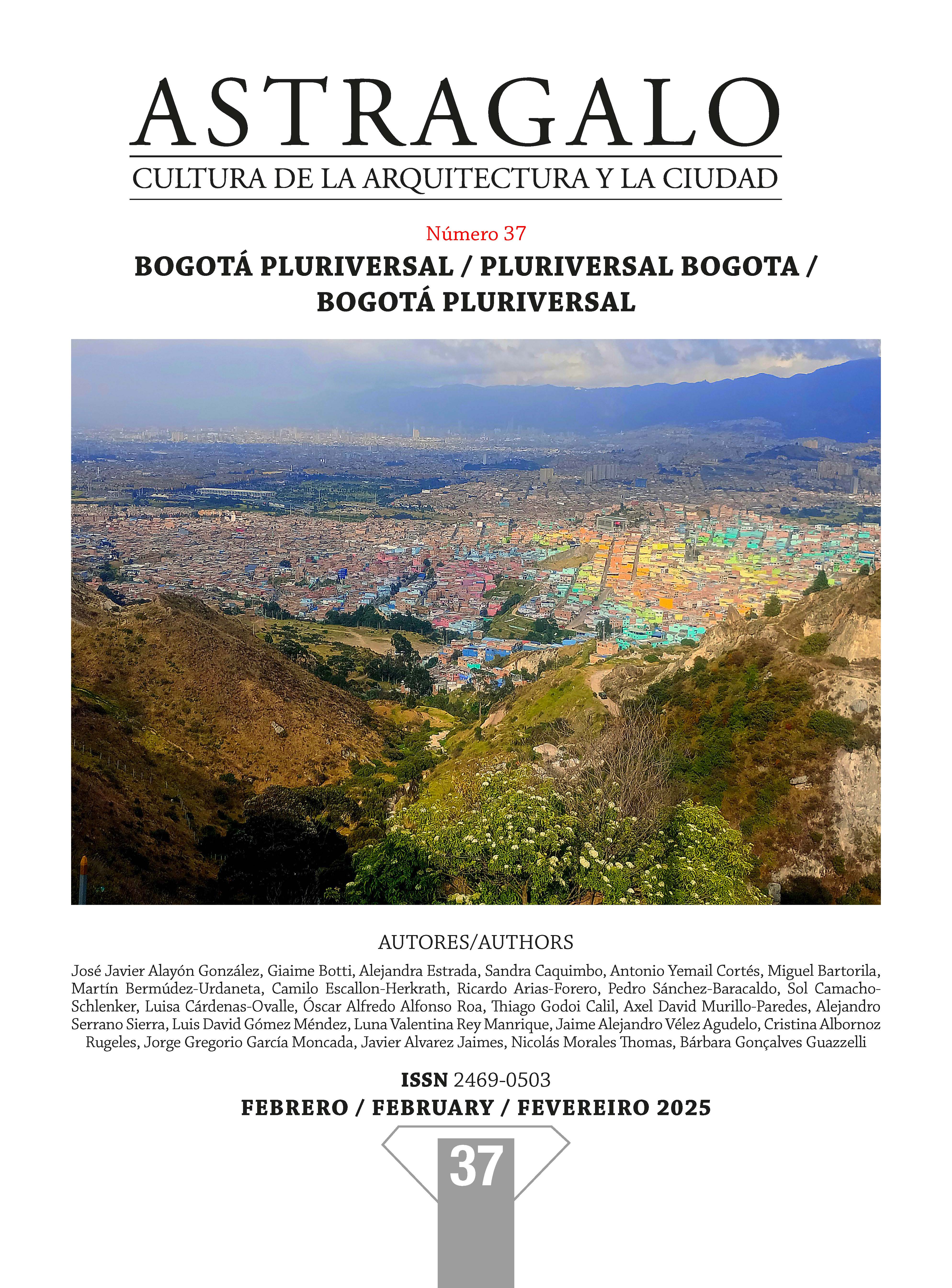
Pluriversal Bogota
Vol. 1 No. 37 (EXTRA) (2025)A36 (EXTRA) PLURIVERSAL BOGOTÁ
The extra issue of 2024 is devoted to Bogotá and its "other worlds". This city - one of the world's highest altitude capitals and by far the most populous of them - sits at 2560 metres above sea level between the Sumapaz páramo, the eastern range of hills and the Cundinamarca-Boyacá highlands. Its municipal urban land is occupied with a medium to very high population density which, since its occupation by the original peoples, has required managing a fragile balance with this territory brimming with water. However, less than 1.5% of its original wetlands remain today. Highlighting this geographical condition and the tensions between the different realities that inhabit it, this monographic issue of the journal Astrágalo on the Andean city joins other intensive looks at cities such as A27 in Delhi or A29 in Seville, which seek a transdisciplinary understanding of contemporary urban phenomena.
The approach of this call is based on two of those that preceded us. On the one hand, the pluriversal politics and the ontological re-equipment of cities by Arturo Escobar in "Designing for a real world" (A30 in 2022) and, on the other, the dis-integration of "Divided cities" by Alona Fernández with Introduction to the number by Roberto Fernández (A29 in 2021). In this sense, we want to question the capital of Colombia about the challenges posed by the first author in order to solve what the second one shows. Some questions in this regard would be: Is there a transition towards a rururban pluriverse? What are the actions that operationalise these decolonial approaches? What does the city contribute to the debate on the future and how does it respond to the socio-environmental conflicts of the present? What socio-environmental conflicts (tensions) have shaped Bogotá and what are the recent urban challenges that respond to them?
The "realities are plural and in continuous construction" explains Escobar (2020) and the urban civilising phenomenon, since classical times, tends to unify and separate us from the earth. Therefore, the concept of the pluriversal city explores the idea of a city where many worlds fit, reconnected with our planet and rethinking our modes of existence on it. We invite those who reflect, propose or execute actions on Bogotá - from architecture, urban planning, landscape architecture, geography, the arts, philosophy, history or sociology - to publish their proposals or results in response to Escobar's call to terraform (re-earthing) cities, or to remedy the conditions of "division, segregation, tearing apart, conflict" proposed by Fernández. We want to place special emphasis on research that contributes to a new design for the pluriverse, a world where there is room for other worlds based on actions such as: recommunalising social life; relocalising social, productive and cultural activities; reinforcing autonomies in the face of globalisation; depatriarchalising, de-racialising and decolonising social relations; or terraforming life and building networks between initiatives and transformative alternatives (Escobar, 2022).
This issue aims to be an X-ray of contemporary Bogotá, an alternative panorama of itself and its relationship with other Colombian, Latin American and world cities. On this occasion, the Visual Article section aims to contrast various perspectives from the perspective of research and creation, and therefore calls for the joint nomination of two or more artists to illustrate the themes of this issue. The selection of the visual article will be the responsibility of the editorial team, who will act as blind peers.
Guest Editors:Dr. José Javier Alayón González (Pontificia Universidad Javeriana, Bogotá, Colombia)
Dr. Giaime Botti (University of Nottingham Ningbo China, Ningbo, China)
Dra. Alejandra Estrada (Pontificia Universidad Javeriana, Bogotá, Colombia)
Dra. Sandra Caquimbo (Pontificia Universidad Javeriana, Bogotá, Colombia)
-
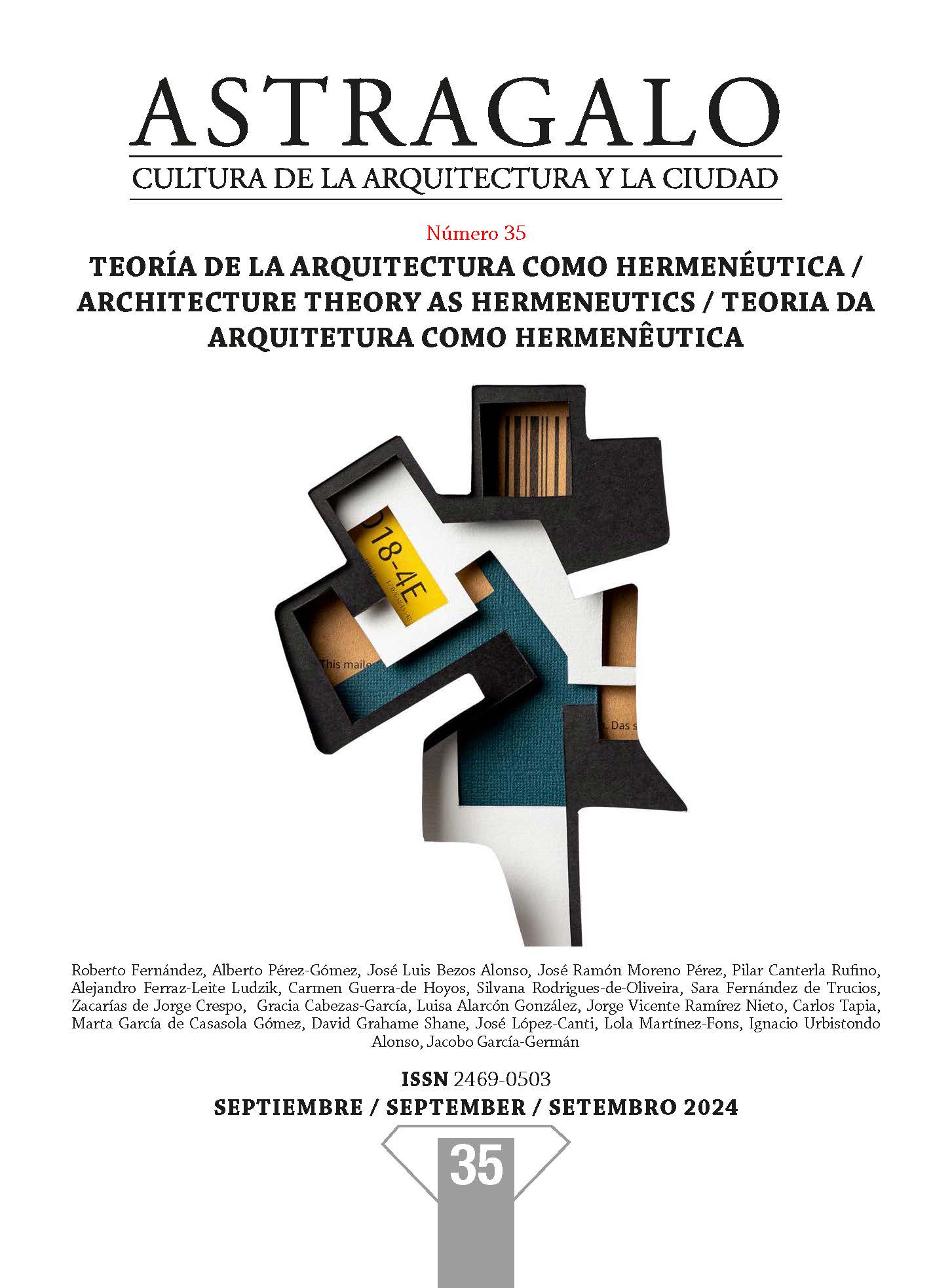
Theory of Architecture as Hermeneutics
Vol. 1 No. 35 (2024)The subject of architecture is not merely aesthetic or technical, if by that we mean autonomous values, as configured in the Western mentality from the 18th century onwards. Rather, it is primarily ethical. The practice of architecture must be guided by a notion of the common good, while retaining a political dimension, understood as the human quest for stability and self-understanding in a changing and finite world. It is about proposing spaces for embodied communication which, by seducing us, promote justice, consequently indispensable for our psychosomatic health. Instrumental theories are unable to account for this dimension, regardless of whether they are driven by technological, political or formal imperatives, or by the desire to emulate some scientific model (for example, recently, bio-mimicry). The alternative that theory can provide for an ethical practice can be found in recent hermeneutic ontology, particularly in the works of Hans-Georg Gadamer, Paul Ricoeur and Gianni Vattimo. I propose the theory of architecture as hermeneutics, understanding language as an emergent phenomenon, in continuity with embodied consciousness, taking up the ontological intuitions present in the late work of Maurice Merleau-Ponty.
Unlike some scientific or deconstructivist methodology, hermeneutics allows us a critical openness to the self-evident qualities of historical artefacts, leading us to recognise and value the responses produced in historical contexts that we identify as meaningful orders. The same mindset suggests a careful and courteous reading of historical documents - the architectural theories of times past, for example - conceding that important questions about the meaning of the discipline underlie the discourse, beyond the limitations imposed by local beliefs, prejudices and power games. The world of our experience includes the artefacts that constitute our artistic traditions, including architecture: spatio-temporal forms whose transformative power we can still discern, in moments of recognition that are entirely new, yet strangely familiar. By understanding these forms of specific embodiment and articulating their lessons in view of our own tasks, we will have a better chance of constructing an appropriate architecture and an intersubjective reality that can fulfil its social and political task as an affirmation of culture. The task of architecture is the formal manifestation of a social and political order out of the chaos of experience, starting with the perceptions of meaning that our culture shares in its habits and embodies in its historical vestiges, projecting poetic alternatives that can transcend the stifling or repressive frameworks of inherited institutions.
Authors are invited to submit articles that reflect on this, taking into account the text that Professor Alberto Pérez-Gómez, guest editor, has prepared to set guidelines or incite responses. We expect elaborate interpretations of buildings or urban proposals, historical reviews of the contexts mentioned therein, current affairs or criticism of what we have wanted to be the object of research, for the monograph that will be called the theory of architecture as hermeneutics.
Guest editor: Alberto Pérez-Gómez. McGill University, Montreal.
DOSSIER (A35): THE LEGACIES OF COLIN ROWE; MATHEMATICS, CONTEXTUALISM, COLLAGE CITY AND BEYOND.
Guess Editor: David Grahame Shane
Colin Rowe transformed and changed over his lifetime, constructing and refining his intellectual and conceptual apparatus in response to his changing circumstances. There can be little doubt that the single most formative experience of the young Rowe was his time with Rudolf Wittkower at the Warburg Institute, after his earlier architectural education at Liverpool University, whose Professor Patrick Abercrombie guided the re-building of London after WW II. Rowe attempted unsuccessfully to adapt Wittkower’s diagrammatic analyses to Le Corbusier’s St Dié with his students Robert Maxwell and James Stirling. Later with the Texas Rangers he began to unpack the Wittkoverian geometry into the urban landscape, studying Le Corbusier’s League of Nations with his colleagues Robert Slutsky, Bernard Hoesli and John Hedjuk. He continued this process to recoup the traditional, classical city via Camillo Sitte in the 1950s with Alvin Boyarsky at Cornell, and then in the mid-1960s with Wayne Copper and Tom Schumaker. From this hybrid base, Rowe constructed a new, meta-historical, reflexive, curatorial apparatus of the “city as museum” outlined in Collage City with Fred Koetter and the Roma Interrotta Team (1978). As argued in Recombinant Urbanism (2005) many of the subsequent Urban Design movements unfolded from this layered, diagrammatic, multi-scalar approach to communal history, memory and the environment in the following half-century ranging from the Neo-Rationalism, De-construction, New Urbanism, Parametric Urbanism, Landscape Urbanism, Ecological Urbanism, Strategic Urbanism, to the emphasis on Historic Preservation, Adaptive re-use, the self-built megacity and the informational city. Even in Covid Urban Designers still struggle with the complexity and contradictions of classical and modern continuities that made Rowe’s intellectual struggle so difficult and dynamic.
It seems an appropriate time to revisit Contextualism and Collage City and Roma Interrotta within the framework of contemporary urban design networks, and the new tools of representation available in the contemporary metacity of information.
In this sense, authors are invited, from among other related instances, to focus on Contextualism, Collage City and beyond, to investigate Colin Rowe’s mid-twentieth century role in appropriating Sitte’s 1890’s reaction to Von Forster’s 1860 imperial design for the Vienna Ringstrasse. Rowe’s critical appropriation paved the way for later iterations and code shifts that greatly expanded into a more fragmented, inclusive Collage City. It took Rowe several iterations to develop this concept with Fred Koetter and with his Roma Interrotta team. Moreover, authors are called to explore strength and weaknesses of the mutations of Rowe’s classical impulse as it, in its turn, evolved with urban design beyond the binary into the 21st century.
-
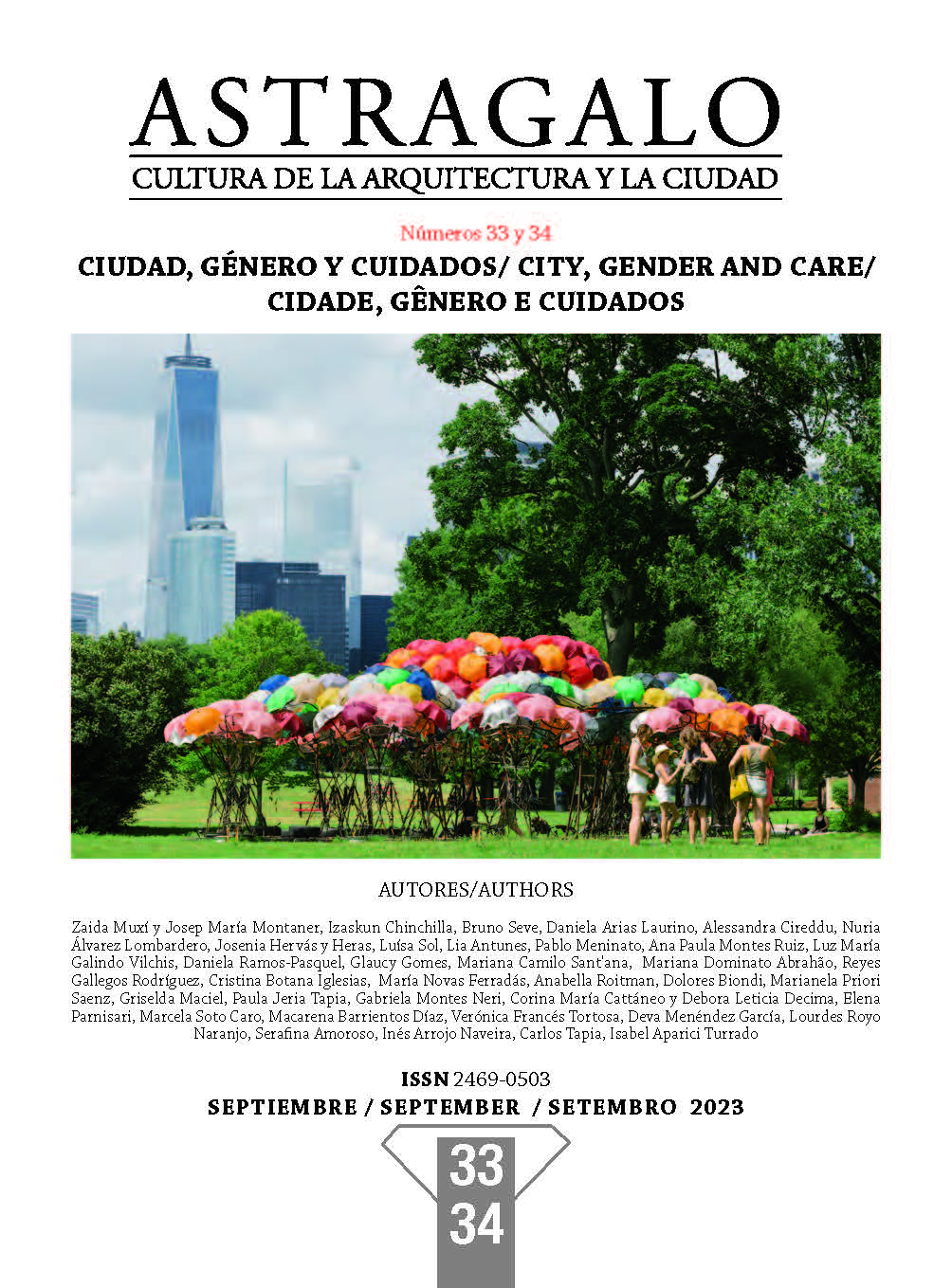
City, Gender and Care
Vol. 1 No. 33-34 (2023)Urban planning is not and has not been neutral. It has essentially been conceived from a patriarchal, capitalist and pyramidal vision, which has given total priority to productive activities, assigned to men and by the male gender. As a result, only the productive sphere has been taken into account, while the other three spheres of human life have been marginalised and made invisible: the sphere of reproduction and care; the sphere of community life, interrelation and social and political activity; and the sphere of personal development.
For this reason, we speak of feminist urbanism, whose prior objective consists of the critical recognition of reality from the perspective of women's experience. In urban area study projects, the working premise of feminist groups is the urban reconnaissance walks, which precede both exploratory walks and daily walks, in which women walk through the neighbourhood in groups, sharing their stories and experiences, and explaining the reasons for each enclave and the perceptions of each specific urban space. Taking to the streets is an act of rebellion and a political action.
And today we turn to ecofeminism, as it brings together the issues of the environmental crisis and the crisis of care: it critically analyses the beliefs that sustain the ecocidal, patriarchal, capitalist and colonial model of our civilisation; based on the nefarious hierarchical pyramid that puts men as the sex at the top and women, animals, trees, vegetation and resources in the lowest and most exploitable strata. Ecofeminism, as a philosophy and as an action, denounces the risks to which people and all other living beings are subjected, proposing alternative approaches to reverse this systematic war that capitalism has decreed against life. It is, in short, a plural and diverse position, rooted in different places. It therefore proposes the recovery of the values of care, applying them to the scale of ecosystem care. In other words, the values of caring for people are extended to caring for society and nature, but this must in no way imply a technophobic and nostalgic return to a pre-technological or essentialist society.
In conclusion, the challenge today lies in constructing new narratives, as opposed to hegemonic stories; new narratives based on feminist demands for equality of people based on differences, placing care at the forefront and confronting the climate crisis. New narratives that analyse and propose what an egalitarian city is and how it transforms the way housing, buildings and public spaces are designed.
Guest editors: Zaida Muxí (ETSA Barcelona) and Josep Maria Montaner (ETSA Barcelona).
-
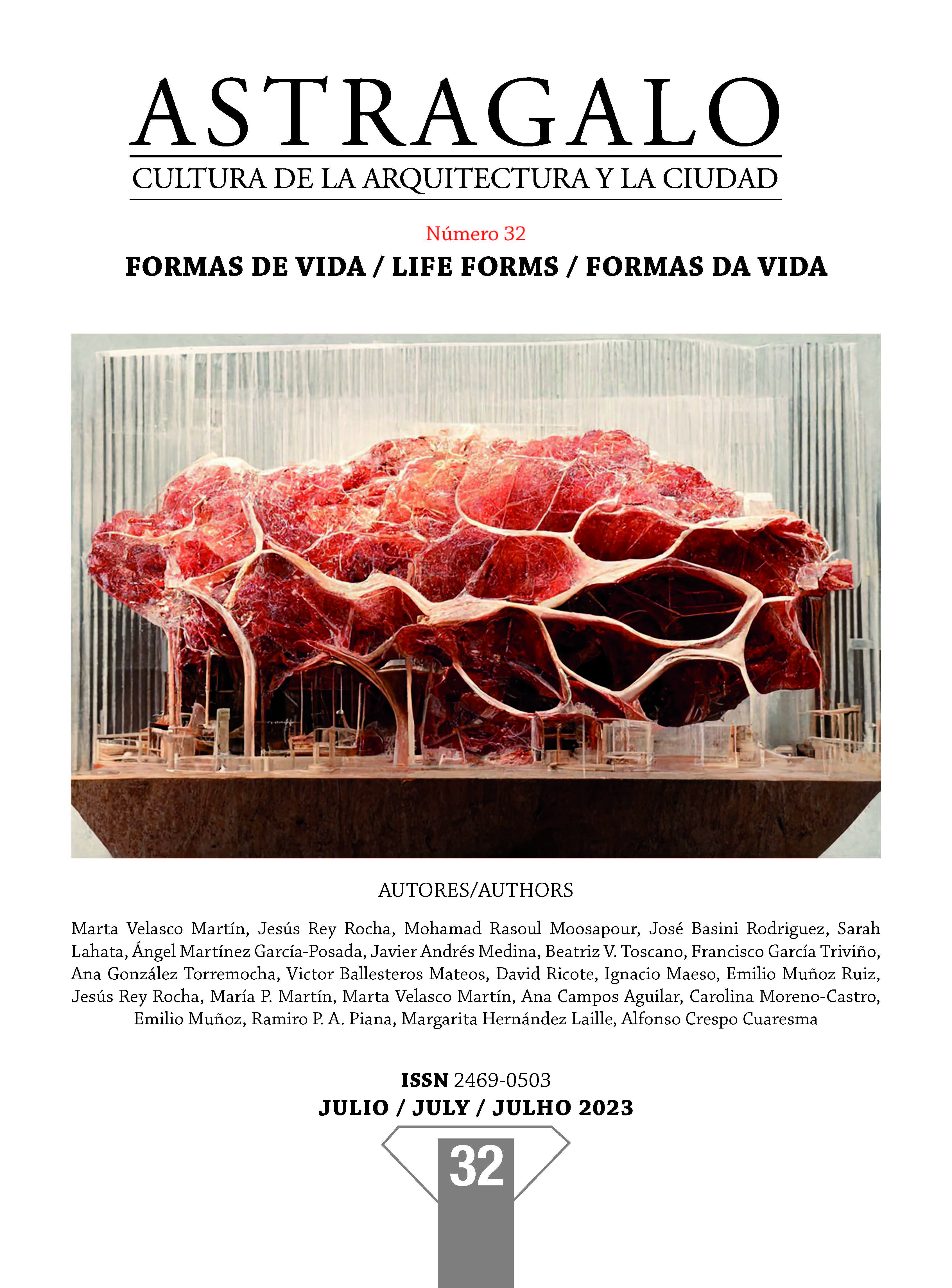
Life Forms
Vol. 1 No. 32 (EXTRA) (2023)Focus:
Maintaining life on planet Earth and the well-being of its inhabitants, human and non-human, animal and plant, bacteria, protists and fungi, both individually and collectively, must be at the top of the political and scientific agendas, especially as our human actions have aggravated the climate and environmental crises in recent years.
Fifty years after the publication of The Limits to Growth report, commissioned from MIT by the Club of Rome, its message is still valid: Earth's interconnected resources - the global system of nature in which we live - are unlikely to be able to support current rates of economic and population growth of the human species well beyond the year 2100, if at all, even with advanced technology; if global population growth, industrialisation, pollution, food production and exploitation of natural resources were to continue unabated, the absolute limits of growth on Earth would be reached, in a situation that could be described as an environmental pandemic.
As the first quarter of the 21st century draws to a close, the human species is facing what we might call an anthropic paradox, for despite the evidence of its contribution to the overexploitation of the planet's resources and the worsening conditions for life on the planet, it is confronted with the yearnings and ambitions of its species to transcend its human condition, to improve life as we know it and, eventually, to become a creator of life. Faced with this situation, some models of societies seem unable to find institutional referents and personal models that provide the certainties and confidence necessary to feel the security on which to live. Moreover, they must face increasing levels of complexity, since not only are there multiple options to choose from, but their advantages and disadvantages are not always clear, are not comparable or are even contradictory (or appear to be so), in other words, they are faced with various trilemmas and plurilemmas.
The monograph 'Life Forms' addresses this anthropic paradox by studying the challenges, impacts and social and philosophical implications of research on the origins, (co-)evolution, diversity and synthesis of life from a multidisciplinary, integrative and collaborative approach that calls upon the expertise of a wide range of disciplines - from the Life, Physical and Chemical Sciences, through Engineering, to the Social Sciences and the Humanities─. We believe that the understanding - and control - of life, from the (sub)cellular to the organismal and systems scale, requires philosophical, ethical, political and social reflection, due to the possible impact of the application of the technologies that make this possible and the results of research in this field; that is, due to the impact of science, technology and human activity, on its own life and on the conditions for life on planet Earth - and eventually on its satellite and other planets. Thus, the development of purely scientific and technological aspects, accompanied by a constant and simultaneous ethical and philosophical evaluation of research, allows the analysis of the progress made and expected, of its implications and social challenges, of its repercussions, benefits, impacts and problems, of its safety and biosafety, of its risks, and of its cultural implications. Furthermore, we believe that the participation of society in them must be considered. We cannot neglect, in this context, the role of citizens: how they are and will be affected and their eventual involvement.
The idea of compiling these reflections in the form of a monograph arose at the meeting "Challenges, impacts and social implications of research on life. Let's think, and reflect together to act" that was held at the Casa de la Ciencia in Seville in May 2022, sponsored by the CSIC's Life-Connections network (LifeHub). This meeting allowed interaction and dialogue between professionals trained in different experimental and social fields, directly or indirectly related to life sciences. For this reason, 'Formas de vida' has been designed to be built in a cooperative way, thanks to the interaction and collaboration of different authors. The monograph is thus conceived as an exercise in dialogue between sciences and cultural disciplines, with the aim of contributing to show the need for this dialogue in order to generate a broader and more innovative vision, capable of evolving in the face of the wide range of changes that are occurring in this first quarter of the century.Astrágalo already published an issue dedicated to this topic in 2017, under the title Elusive city. Forms of life and modes of existence [https://editorial.us.es/es/num-23-2017]. With this new issue, we intend to revisit the theme 'Ways of life', treating it from a perspective that results from the combination in interaction between the Life, Physical and Chemical Sciences, Engineering, Social Sciences and Humanities, through the research tools that are specific to them, without forgetting the interactions with the architectural, spatial, cultural, urban, geographical and artistic spheres, which are the journal's own themes.
Guest editors:
Marta Velasco Martín
Assistant Professor in the Department of Medical Sciences, University of Castilla-La Mancha (UCLM) and researcher in the Health, History and Society group of the Regional Centre for Biomedical Research (CRIB, UCLM). LifeHUB.CSIC Network
Degree in Biology (Universidad Autónoma de Madrid), postgraduate degree in Interdisciplinary Gender Studies (Universidad Autónoma de Madrid) and PhD in Logic and Philosophy of Science (Universidad de Salamanca, Instituto de Filosofía del CSIC). Her doctoral thesis entitled "Drosophila genetics and gender: circulation of objects and knowledge" obtained the qualification of outstanding cum laude and Extraordinary Doctoral Prize for the 2018-2019 academic year. Her lines of research address the history of women scientists; the study of the influence of gender in the construction of biomedical knowledge and in cultural and historical studies of science and technology; and the social construction of disease in the 20th and 21st centuries, as well as collective responses and the establishment of measures to combat them from a gender perspective.
Jesús Rey Rocha.
Department of Science, Technology and Society. Institute of Philosophy, Spanish National Research Council. (IFS, CSIC). Red LifeHUB.CSIC.
-
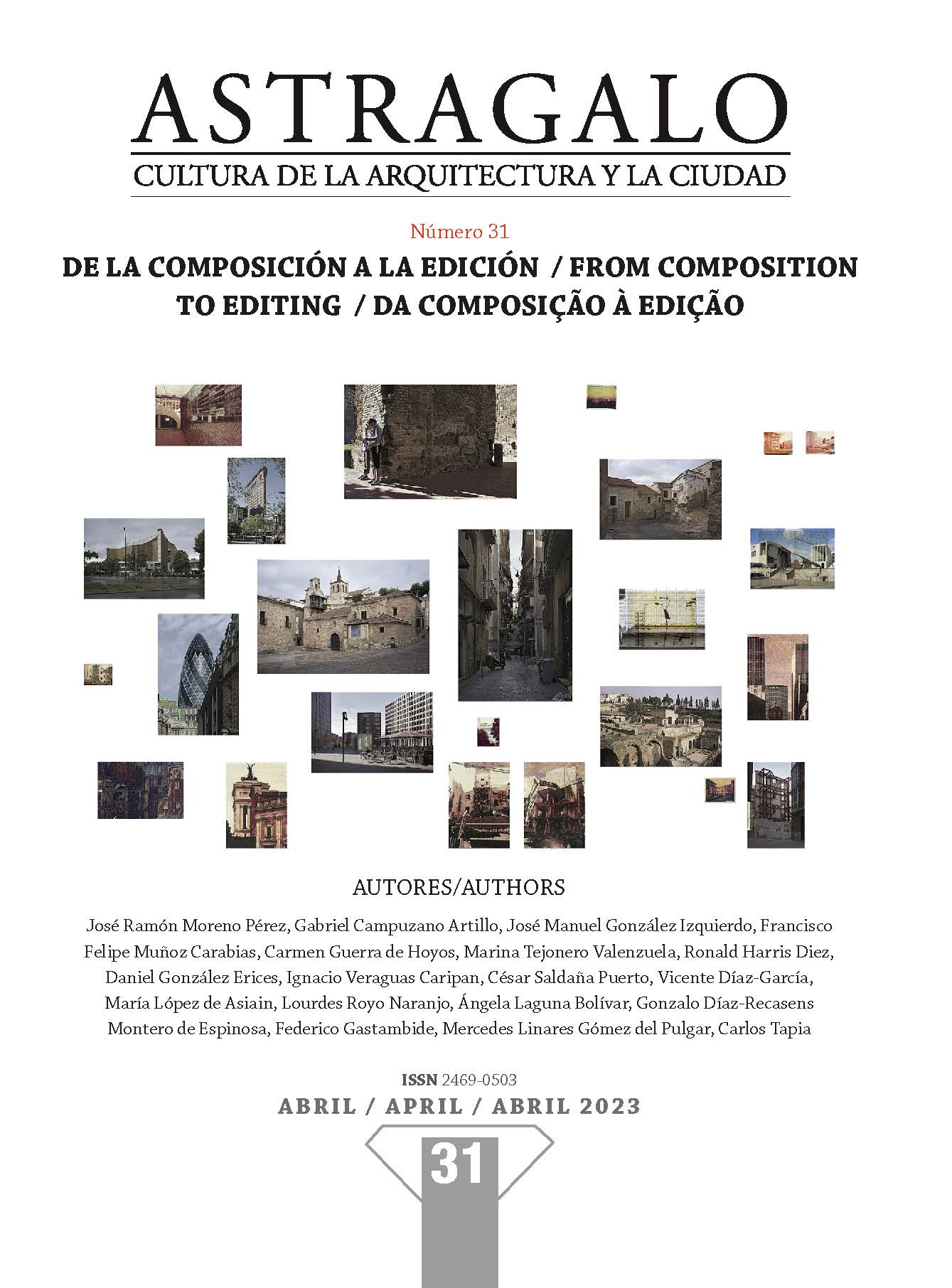
From composition to editing. la edición.
Vol. 1 No. 31 (EXTRA) (2023)The transition between globalisations has been experienced in the field of architecture unconsciously, randomly and collected by a multiplicity of insufficient and partial responses, in a complex process mediated by the obligatory incorporation into contributory and productive networks. We would say that, without hardly feeling it, contemporary architecture has been subjected to a process of continuous editing by external agents who have seductively dictated its inexcusable adaptation to their languages, their presentations, values and procedures. In its tour de force, with these external requirements that sought to insert it into an interior even more powerful and enveloping than its own, architecture has mutated into a body, traversed by multiple practices, that is never capable of showing anything but a hologram of its appearance, in which the memory - or at least the traces - of its historical natures are incorporated.
The call that we have entitled "from composition to edition", delimits a space of contributions that is undefined in its own limits, unless we investigate the reality of both. Thus, composition as a concept of order and power, of hierarchy and system, would have been deconstructed by a complex practice full of singularities and essays, which provide the first trace of an unconscious mutation and, from the other extreme -if it really is-, we would have converged on the considerations of fluidification of the preceding categories: order, system, hierarchy..., to insert the monstrous body of the architectural into a symbiont as a production proper to post-production that would shape it in the contemporary support of communicative materiality.
We are aware that the call for this monographic issue of Astrágalo is aimed at contributions that act reflexively on this growing complexity, of which it is impossible today to implement a characteristic entity, but whose state encourages an open debate attentive to other positions, in which crossroads can be guessed at as a result of the confluence of the paths opened up by a research seduced by the very object it is incapable of shaping. This would at least encourage an incipient topology of the quotidian in which it would be possible to glimpse ways back.
-
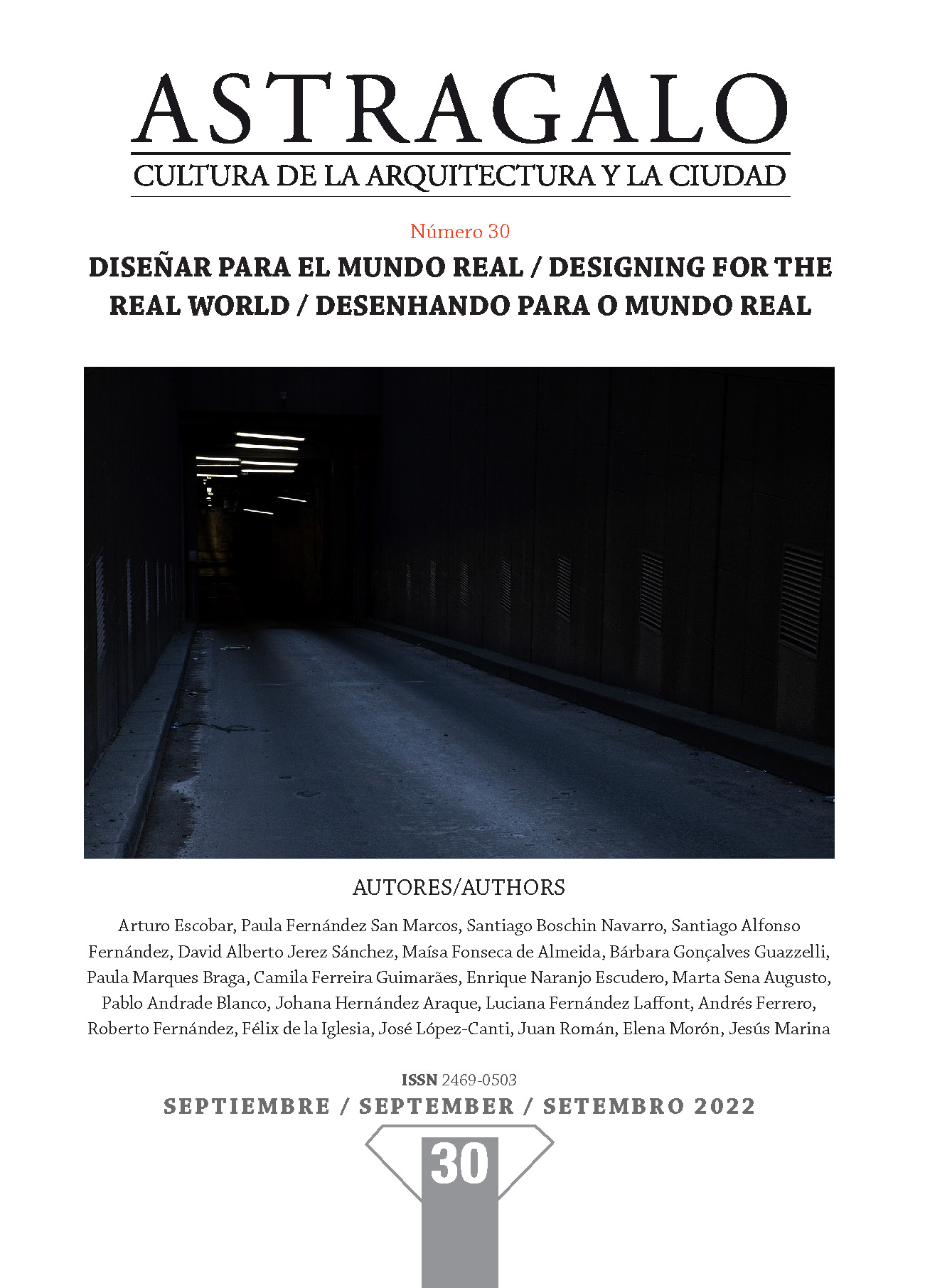
Designing for the real world
Vol. 1 No. 30 (2022)To the insidious and recurrent question of excluding latitude about what it is to project as opposed to design, is added the tragicomic hesitation about what reality might be, or better, among the possible ones, the one that will be the one that will be the one to be decanted for a mere survey, which is not a determining objective.
Having already crossed - as paths, but also as lacerating blows - the economic crisis of 2008 and the pandemic crisis of 2020, and suspecting that they are the same, a positioning is needed that is, at the same time, an action, renewing the key arguments of the disciplines that before these crises traditionally had social attribution, that is to say, all of them.
Renewing means not only rethinking what architecture is today, but also what world it is, what reality it reveals. If we admit design as a category of categories, placed in the dimension "World", it entails considering "everyday life, but goes on to infrastructures, cities, inhabited space, medical technologies, food, institutions, landscapes, the virtual and, ultimately, experience" if we follow the reflection that Arturo Escobar made in "Autonomy and Design, the realisation of the communal" in 2016.
In the constitution of any statute of renewal, a state of the question appears, based on a background in order, consequently, to bet on the radicality of what was not feasible up to that moment. The dislodging of the Modern base, which permeates everything with its exact inadequacy, would have, in such an act of renewal, an absorption cloth with which to clear the consequences in order to make visible what we have as a common foundation.
Some, using guarantors who have limited degrees of freedom, appeal to fraternity and forgiveness for cohesion. Others, autistic, maintain that the crisis is a transition and that we will get out of it sooner or later. There are those who take advantage of the news of the last few days, with the miserable consequence of its acceleration.
Real worlds, distant yet interacting, whose final clause of the constitution of the feasible leaves the door open to action generated by an ontological key of design where there are no specialists but responsibilities disseminated to achieve autonomy and formulate forms-of-life.
Guess Editor: José Enrique López-Canti Professor at Universidad de Sevilla
Authors who wish to participate in this issue may take into consideration, as a guide, extension or critique, the text produced by Arturo Escobar, who generously collaborates by contributing conceptual bases to this issue of Astrágalo:
On the Ontological Metrofitting of Cities. Arturo Escobar. 2022
-
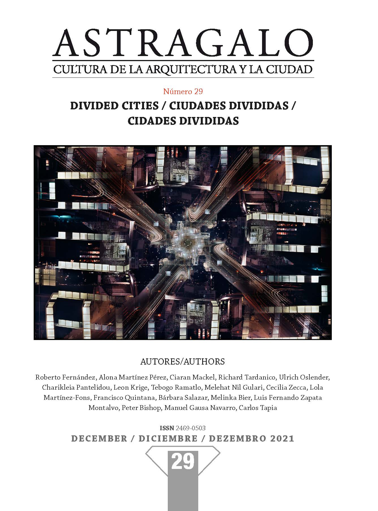
Divided Cities
Vol. 1 No. 29 (EXTRA) (2021)This number of Astragalo looks at the concept of divided cities. The idea of division for this number is multi-faceted. We are looking at cities divided by conflict such as Belfast, Nicosia, Jerusalem. In this case two different cultures, faiths, groups create an urban assemble of walls and artefacts. We look at cities divided by race, like Post-apartheid in South Africa, where a system of racial segregation leaves traces of a past, wherein different races had to leave and be segregated in different areas. From the streets of Soweto, to the vertical slums of Hillbrow in Johannesburg. Cities that met those challenges and behind pain and history, told a positive story. We look at cities divided by racial segregation, by painful experiences that halt our very basic humanity. We look at cities divided by capital, where displacement of the poor out of wealthy, areas creates a disjointed urban imprint. Cities with processes of gentrification, or social and economic division. We look at cities divided by edges, and borders where suburban conurbations gather different inhabitants. Divided cities welcome contributions from all of these examples mentioned. We look for original and brave contributions, from within. Those who challenge our preconceived ideas, those that conjoin in that tension causes by division.
Guest editor with the issue in charge: Alona Martínez. De Montfort-Leicester University
-
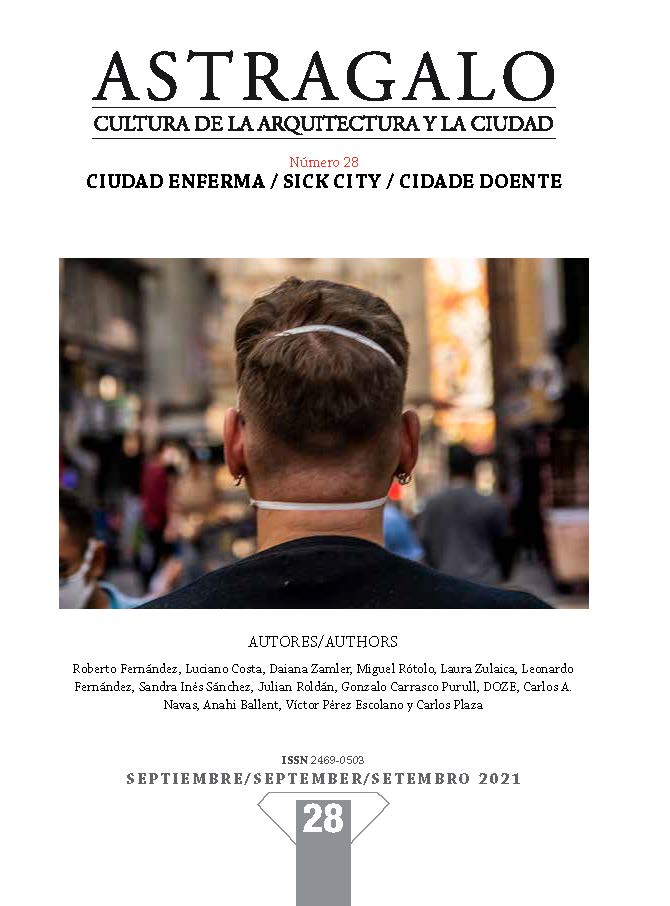
Ciudad Enferma
Vol. 1 No. 28 (2021)SICK CITY
The virosal coronation of the world 2019-20 (21?) raises philosophical, political and vital concerns and calls or demands to think again about the already devalued theoretical-disciplinary arsenal of architecture.
For the time being, the virtuous restoration of the Foucaultian hell of panoptics and different models of reclusion and therapeutic segregation of bodies can be seen. What took a century to counteract - that insidious functionalist vocation of separating, distinguishing and classifying, which perhaps unites the ideas of the end of the 18th century with the spirit of the CIAM - is reborn, valued by the hygienists who cry out for help from specialist-spatialists who ensure social distances and porosities as well as manage to make the lockdowns more pleasant. With concerts of balconies and unusual plant arrangements and various effects to avoid spatial deficits.
To help you think about this intense current situation, it will be worthwhile to point out some directions for reflection:
1 At a distance, it may be interesting to analyse the social diseases of the mid-19th century (which had been recurring with different intensity and location at least since the medieval Black Death) as circumstances that produced the beginning of hygienist thinking (with Richardson's Hygeia for example) and the infrastructural will to improve the sanitation of cities through an evident transfer of utility from the nascent industrial capitalism to finance this modernisation. The industrialists of the 19th century -Engels was one of them- as well as the malevolent Henry Ford today seem to be candidates for the Nobel Peace Prize, compared to the inhuman (not post-human) ferocity of the select world club of billionaires.
2 The pandemic becomes a syndemic (a new name that seems to exalt its magnitude) as a double consequence of economic-cultural globalization and the intensity of liquid economies-cultures according to the viscous nickname applied by Bauman, liquidating in one sense the quality of the world - devastated nature that allows the flourishing of a multitude of zoonoses - and in another, compromising global health because now things, people and information flow (or flowed until just yesterday). There is at least a 30-year history of serious and diverse zoonoses, as reported by David Quanmen, which did not achieve non-pandemic status simply because absolute globalisation had not reached its zenith.
3 It is curious to note an almost joyful return to a certain ultra-valuation of the criterion of a medieval city, not only in the already pre-announced neo-medievalities described by Eco since the 1970s as an expression of apocalyptic cultures, but more recently in the desperate notion of proposing the 15-minute city, whose graphics proposed by Carlos Moreno - one of his apologists - are singularly similar to the artisan's quartiers of the 13th century, even drawn by hand. A little more sophisticated - through rendering - but the same in trying to propose the creation of small residential nuclei with the aim of integrating work and food production into the whole is the project that Guallart Architects developed to propose the New Area of Xiong'an, which is 120 kilometres from Beijing and is announced as the first post-covid city.
4 As a slightly allusive expression of establishing one's place in the world of each of us, a radical terraplanarist geometry of lines, points and crosses is proliferating everywhere, either as indications of the desire for emptiness (in underground stations or while waiting for the dentist), or as gentle instructions for distancing and sponging each body ideally separated from all others by clinically recommended distances, All of which organizes humans in rows to access the cash machines or the supermarket checkouts and which unfolds a new kind of drawn city, in a rather regularized and modular op art that even feeds the most audacious innovations of Covadian urbanism that, as in Barcelona, paint the streets and pavements with abundant white and yellow graphics that propose pedestrian and bicycle spaces and banish buses and cars, thus feeding new formats of suburban cities.
5 In the polarity of Chinese development - embodied by Wuhan, the city where it all began, where bat soup is eaten but which is also (or because of this) the capital of 5G - the recent urbanity agglomerates people who maintain intense features of rural culture (eating any live animal and not with better natural health but with worse statistics and health treatments) and who are disciplined like few others to submit to the kind of vigilance they chose in nearby Samsung Korea, whose technology also manages to connect healthy and sick people live, bringing new and intense versions of a great new brotherhood that, beyond the Orwellian horrors, seems to have saved lives by detecting each new infected person and their movements in real time. From this strengthening of the meticulous tracking of the life of each South Korean, the idea of electronic salvation is spreading over the world, in which each one will be able to survive from now on to the disease but also to other issues such as work, education, delivery and even to the various instances of emotional relationships.
6 And the most radical but still invisible end: the apparent collapse of the global economy (at least with a crisis of the greatest magnitude that we can remember), the unfathomable drifts of antisocial policies (from Trump and Bolsonaro to the extended European pleiadings of different interpreters of the amicably called new right), no glimpse or concrete manifestation of redirecting the planet towards the cessation of global warming and the regression of biodiversity, and a whole agenda that is necessary to reinterpret the perspective of better territorialities.
Astragalo invites interested authors from different disciplines who know how to address the above arguments to participate through articles and reviews. As a reflective basis, the lead article by Professor Roberto Fernández, which will be published in this issue, can serve as a focus of attention and critique, even for authors who wish to participate in this call for papers:
SIETE NOTAS SOBRE LA INMUNDA CORONACION.pdf (Only in Spanish)

